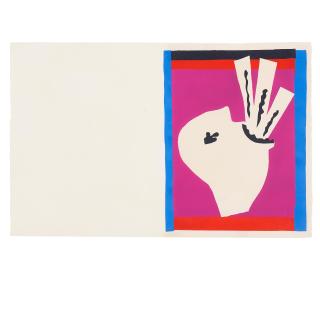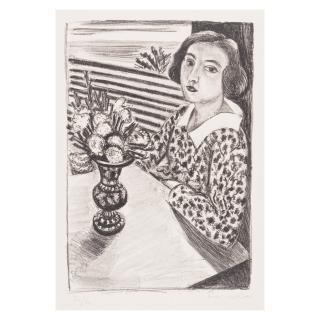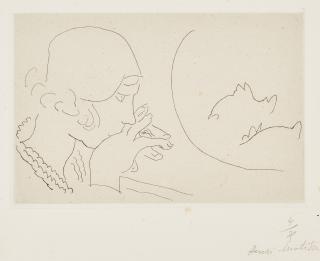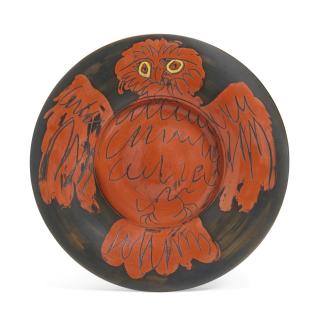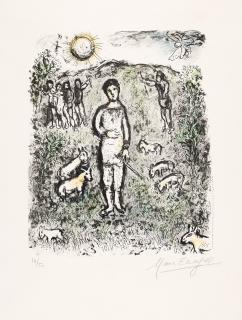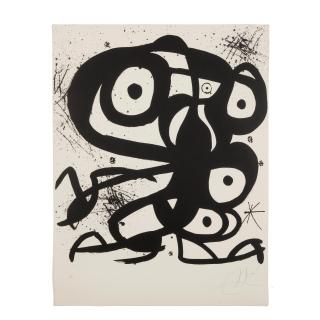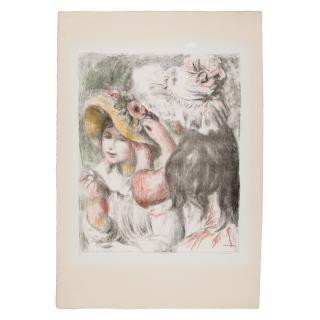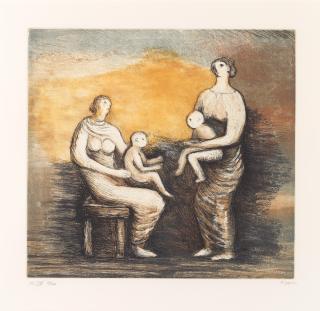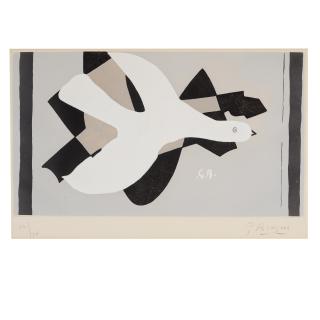Henri Matisse Le Cateau - Cambrésis, France 1869 - 1954 Nice
The artist Henri Matisse
- One of the most important artists of the early 20th century and leading figure of Fauvism.
- His stay in Collioure with Derain and Vlaminck is considered the birth of Fauvism.
- A curch window commissioned by the Rockefellers was his last work shortly before his death.
Henri Matisse is undoubtedly one of the most important artists of the early 20th century - and thus of Classical Modernism. Born in 1869 in Le Cateau-Cambrésis, Henri Émile Benoît Matisse grew up in France as the son of a seed-trading family. On his way to becoming the leading figure of Fauvism, the French painter first had to undergo an appendectomy at the age of 21, followed by bed confinement, before he devoted himself wholeheartedly to painting.
So he finally began to study at the École nationale supérieure des Arts Décoratifs in Paris and started travelling. In the meantime, he became familiar with the works of van Gogh and Turner, so that he first imitated their style and then immersed himself more deeply in the Impressionist and Naturalist painting styles. Matisse's stay in a small fishing village on the Mediterranean, which he visited together with André Derain and Maurice de Vlaminck in 1905, is regarded as decisive and later as a key experience for the emergence of Fauvism.
In Collioure, in the south of France, the three honed their style and for the first time turned away from their hitherto familiar Impressionist scheme. The name Fauvism goes back to the exhibition of Matisse's, Vlaminck's and Derain's works that took place in the same year at the Salon d'Automne in Paris. On display there were the works from the time in Collioure, which met with harsh criticism. Art critic Louis Vauxcelles is supposed to have called the three of them »Fauves« (wild animals) as a consequence.
Henri Matisse was known for his style of flat colouring and tense lines. Having already survived duodenal cancer and two pulmonary embolisms in the 1940s, he succumbed to a heart attack in Nice in 1954. In the days before his death, he was still working on the Rockefeller Rose, a stained glass window for the Union Church of Pocantico Hills – it was to be commissioned by the Nelson Rockefeller family.
Der Künstler Henri Matisse
- Einer der bedeutendsten Künstler des frühen 20. Jahrhunderts und Leitfigur des Fauvismus.
- Aufenthalt in Collioure mit Derain und Vlaminck gilt als Geburtsstunde des Fauvismus.
- Arbeitete bis kurz vor seinem Tod noch an einem Kirchenfenster im Auftrag der Rockefellers.
Henri Matisse zählt zweifelsohne zu den bedeutendsten Künstlern des frühen 20. Jahrhunderts – und somit zur Klassischen Moderne. Der 1869 in Le Cateau-Cambrésisgeborene Henri Émile Benoît Matisse wuchs als Sohn einer Samenhandelsfamilie in Frankreich auf. Auf seinem Weg hin zur Leitfigur des Fauvismus musste der französische Maler im Alter von 21 Jahren erst eine Blinddarmoperation mit anschließender Bettlägerigkeit durchleiden, bevor er sich mit ganzer Leidenschaft der Malerei widmete.
So begann er schließlich an der École nationale supérieure des Arts Décoratifs in Paris zu studieren und auf Reisen zu gehen. Währenddessen setzte er sich eingängig mit den Arbeiten van Goghs und Turners auseinander, sodass er zunächst deren Stil imitierte und tiefer in den impressionistischen sowie den naturalistischen Malstil eintauchte. Ausschlaggebend und später als Schlüsselerlebnis für die Entstehung des Fauvismus angenommen, gilt Matisses Aufenthalt in einem kleinen Fischerdorf am Mittelmeer, das er 1905 gemeinsam mit André Derain und Maurice de Vlaminck bereiste.
In Collioure, im Süden Frankreichs gelegen, feilten die drei an ihrem Stil und wandten sich erstmals von ihrem bis dahin bekannten, impressionistischen Schema ab. Der Name Fauvismus geht auf die Ausstellung von Matisses, Vlamincks und Derains Werke zurück, die noch im selben Jahr im Salon d’Automne in Paris stattfand. Dort zu sehen gab es die Arbeiten aus der Zeit in Collioure, die auf harsche Kritik stießen. Kunstkritiker Louis Vauxcelles soll die drei infolgedessen als »Fauves« (wilde Tiere) bezeichnet haben.
Henri Matisse war für seinen Stil aus flächiger Farbgebung und spannungsgeladenen Linien bekannt. Nachdem er in den 1940er Jahren bereits Zwölffingerdarmkrebs sowie zwei Lungenembolien überlebte, erlag er 1954 in Nizza einem Herzanfall. An den Tagen vor seinem Tod arbeitete er noch an der Rockefeller Rose, ein Glasfenster für die Union Church of Pocantico Hills – es sollte im Auftrag der Familie Nelson Rockefeller entstehen.
Henri Matisse in a nutshell
Matisse, alongside André Derain and Maurice de Vlaminck, is considered a key figure in Fauvism. The three of them are supposed to have stayed together in the small French fishing village of Collioure on the Mediterranean in 1905, where they honed their styles together. For the first time, they abandoned Impressionism. In the same year, works from this period were shown at the Salon d'Automne in Paris – where they were not received very well. It is said that the art critic Louis Vauxcelles, out of indignation, called the three artists »Fauves« (wild animals) and thus laid the foundation for the style of Fauvism.
The Frankfurter Rundschau wrote in 2014 of a Matisse exhibition at the Tate Modern in London that »intense colours, movement and cheerfulness« characterise Matisse's silhouettes. He used scissors, paper and tacks for his distinctive paper cuts, which dominate his last creative phase. With a flick of his tailor's scissors, he transformed the inked paper into natural motifs such as swarms of bees, swallows, flowers or women's bodies. He arranged the individual luminous and dancing outlines into compositions that evoke the impression of serial printing techniques when viewed. He himself described this working technique as »painting with scissors.«
Häufige Fragen zu Henri Matisse
Matisse gilt zusammen mit André Derain und Maurice de Vlaminck als Schlüsselfigur des Fauvismus. Die drei sollen sich 1905 gemeinsam in dem kleinen französischen Fischerdorf Collioure am Mittelmeer aufgehalten und dort gemeinsam an ihrem Stil gefeilt haben. Zum ersten Mal wandten sie sich vom Impressionismus ab. Noch im selben Jahr waren die Arbeiten aus dieser Zeit im Salon d’Automne in Paris zu sehen – wo man sie nicht unbedingt gut aufnahm. Es heißt, dass der Kunstkritiker Louis Vauxcelles die drei Künstler aus Entrüstung als »Fauves« (wilde Tiere) beschimpft und damit den Grundstein für die Stilrichtung Fauvismus gelegt haben soll.
Die Frankfurter Rundschau schreibt 2014 einer Matisse-Ausstellung in der Tate Modern in London, dass »intensive Farben, Bewegung und Frohsinn« Matisse' Scherenschnitte kennzeichnen. Er nutzte Schere, Papier und Heftzwecken für seine markanten Papierschnitte, die seine letzte Schaffensphase dominieren. Mit einem Griff zur Schneiderschere verwandelte er das eingefärbte Papier in Naturmotive wie Bienenschwärme, Schwalben, Blumen oder Frauenkörper. Die einzelnen leuchtenden und tanzenden Umrisse arrangierte er zu Kompositionen, die beim Betrachten den Eindruck serieller Drucktechniken evozieren. Er selbst bezeichnete diese Arbeitstechnik als »Malen mit der Schere.«
Henri Matisse quotes
Zitate von Henri Matisse
Henri Matisse in News and Exhibitions
Crisis and late masterpieces
Around 1930, Henri Matisse was a famous painter who, as a pioneer of Fauvism, had a decisive influence on Classical Modernism. At this time, he was going through a creative crisis, which was followed by a groundbreaking late work. From 19 October, visitors to the Philadelphia Museum of Art can follow Matisse in the 1930s chronologically.
After 110 years: Works of art by Matisse reunited
It is considered one of the most influential works of modern art: The Red Studio (1911) by Henri Matisse. From May 1 to September 10, it will be on view in the exhibition of the same name at the Museum of Modern Art in New York, united for the first time in 110 years with the works depicted on it.
Henri Matisse in News and Exhibitions
Krise und späte Meisterwerke
Um 1930 war Henri Matisse ein berühmter Maler, der als Wegbereiter des Fauvismus entscheidenden Einfluss auf die Klassische Moderne hatte. Zu diesem Zeitpunkt befand er sich in einer Schaffenskrise, auf die ein bahnbrechendes Spätwerk folgte. Ab dem 19. Oktober können Besuchende im Philadelphia Museum of Art Matisse in the 1930s chronologisch nachverfolgen.
Nach 110 Jahren: Kunstwerke von Matisse wieder vereint
Es gilt als eines der einflussreichsten Werke der Moderne: The Red Studio (1911) von Henri Matisse. Vom 1. Mai bis zum 10. September ist es in der gleichnamigen Ausstellung im Museum of Modern Art in New York zu sehen, zum ersten Mal seit 110 Jahren ist es vereint mit den Werken, die darauf abgebildet sind.

